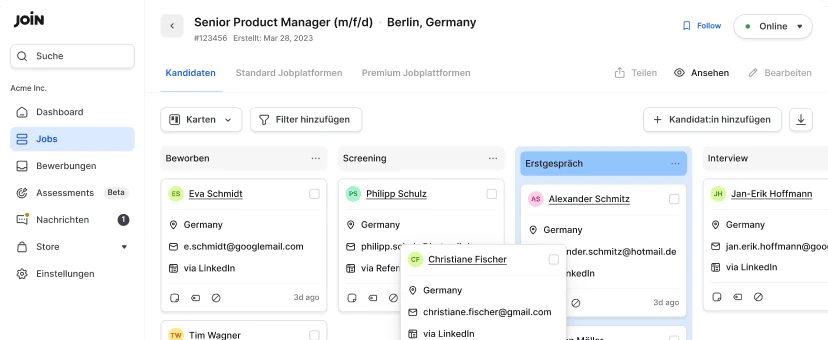Building a talent pipeline for more efficient recruitment
Your recruitment efforts don’t always have to start with an open position. In fact, as a recruiter, you can often no longer afford to wait for job openings to start your search for candidates.
You need to take a proactive approach and build a talent pipeline.
A talent pipeline allows you to streamline the hiring process, reduce time-to-hire, and hire better candidates. This article explains what a talent pipeline is (and what it’s not), the steps to building a talent pipeline, and the benefits it can bring to your business.
Here’s what you’ll learn:
Table of contents
What is a talent pipeline?
A talent pipeline is a collection of qualified job candidates that your company may want to hire for existing or future positions.
You might know the term “pipeline” from a business perspective from other areas, like Sales or Marketing. In recruitment and talent management, the meaning of the “pipeline” refers to always having a source of talent to tap from.
Keeping such a recruitment pipeline is a proactive approach to recruiting that ensures you have a pool of potential hires ready to fill open positions.
Building a talent pipeline requires creating and nurturing long-term relationships with candidates, even before there is an immediate need to fill a role.
Difference between talent pipeline, talent pool, and talent community
You might have heard of a talent pool or talent community before and find yourself now wondering how the talent pipeline is different. But understanding the distinctions between the three is key to fostering a strategic approach to talent acquisition and talent management.
Let’s break it down:
Talent pipeline
A talent pipeline is a proactive approach where a company cultivates relationships with potential candidates to potentially hire them for upcoming roles. It involves strategic planning to align the stream of candidates with the organisation’s future needs.
Talent pool
A talent pool refers to a database of potential candidates that the company can contact during vacancies. This repository may categorise individuals based on various attributes such as skills or experience and serves as a ready resource for recruitment needs.
Talent community
A talent community is a dynamic space where interested candidates can engage with both the company and each other, often facilitated through social media or forums.
It aims to foster deeper relationships through regular engagement and networking, building a community of knowledgeable and enthusiastic individuals about the company.
In brief, these concepts represent different levels of engagement and strategy in talent acquisition:
- Talent pipeline: A strategic approach to actively nurturing relationships with candidates, focusing on future hiring needs.
- Talent pool: A static collection of candidate profiles available for outreach during job vacancies, representing various levels of engagement with the company.
- Talent community: An interactive platform fostering a sense of community and continuous engagement between potential candidates and the company.
Take this example. Say you’re a Talent Acquisition Specialist looking for a Brand Designer to hire for a Berlin-based company.
Your talent pool would, for example, contain all Designers in Berlin with at least five years of experience. You might have interacted with some of them in the past, but most of this pool consists of prospective candidates you’ve never met before.
Your talent pipeline, on the other hand, includes only qualified candidates who fit the job requirements, who you have communicated with in the past, and who are Berlin-based or open to work in Berlin.
Your talent community, finally, could be a Discord group of Designers in Berlin.

Benefits of a talent pipeline
Building a talent pipeline offers several benefits for businesses:
1. Reduce time-to-hire
Through recruitment pipeline management, recruiters can significantly reduce the time it takes to fill open positions (time-to-hire). Instead of starting the hiring process from scratch each time, recruiters can simply tap into their pipeline of qualified candidates.
2. Hire better candidates
When recruiters have a talent pipeline in place, they can take a more strategic and long-term approach to hiring. This allows them to attract top talent for the job rather than making rushed decisions to fill immediate needs.
3. Improve candidate experience
A talent pipeline enables recruiters to build relationships with candidates over time, providing a more positive and engaging candidate experience.
By engaging with candidates on their own terms and nurturing them throughout their journey, recruiters can create a more personalised and informative experience.
4. Enhance diversity and inclusion efforts
Talent pipelines can be instrumental in increasing diversity and inclusion within organisations. By actively sourcing and nurturing diverse candidates, companies can ensure a more inclusive hiring process and a more diverse workforce.
Building talent pipelines in 6 easy steps
Now we’ve covered the talent pipeline meaning and benefits, it’s time to see how you can actually build it from the ground up. Below, we break down how to create a strong talent pipeline strategy in six clear steps.
Did you know you can keep track of potential talent more easily and effectively with an applicant tracking system (ATS)?
Combined with many other handy features – such as job ad multiposting and creating your own personalised career page – this type of dedicated recruitment software helps you streamline, speed up, and automate your recruitment process.
And with JOIN’s free recruiting software, you can start benefiting from this, and more, today:
Step 1: Identify your company’s long-term goals and needs
The first step in building a talent pipeline is to identify your company’s long-term goals and needs.
This involves understanding your company’s strategic direction and anticipating future growth or changes that may impact your hiring needs. Consider factors such as expansion plans, restructuring, or mergers and acquisitions.
By adopting a forward-thinking mindset, you can prepare your talent pipeline for any potential outcome.
Step 2: Develop a candidate sourcing strategy
Once you have identified your company’s needs, it’s time to develop a candidate-sourcing strategy to fill your talent pipeline. Check out our Glossary for a detailed definition of candidate sourcing.
This strategy should be ongoing and proactive, aimed at actively searching for qualified candidates rather than waiting for them to apply. Some effective sourcing methods include social sourcing (using platforms like LinkedIn) or establishing an employee referral program, in which you ask your current employees to refer potential candidates in return for a reward.
For more sourcing ideas, check out these two dedicated articles:
Step 3: Engage with new candidates
Once you’ve identified potential candidates, it’s important to establish contact and start building relationships.
This initial contact should focus on getting to know the candidate and their career goals. Avoid immediately pushing specific job openings and instead focus on creating a genuine connection. This approach is more candidate-friendly and allows for a more personalised engagement.
Especially as many individuals will be passive candidates, meaning that they’re not looking for a job at the moment, you don’t want to come on too strong.
Step 4: Assess your potential future candidates
As your talent pipeline grows, it’s crucial to assess the candidates in your pipeline to ensure they align with your company’s needs and company culture.
Consider factors such as their experiences, skill sets, challenges they may face, and their potential for growth within your organisation. This assessment will help you identify any gaps in your talent pool and refine your sourcing strategy accordingly.
Step 5: Nurture the candidates in your talent pipeline
Effective talent pipeline management is all about nurturing your future talent. It’s an ongoing process.
It involves providing relevant, engaging content that aligns with their interests and career aspirations. Again, avoid bombarding them with job listings and instead focus on building a long-term relationship based on trust and mutual growth.
By nurturing candidates, you increase the likelihood of them choosing your company when they are ready to make a career move.
Step 6: Prioritise ongoing training and development
Even after hiring candidates from within your talent pipeline, your work does not end. Prioritising ongoing training and development is essential to ensure their continued growth and success within your organisation.
Offering learning and development programs shows your commitment to employee engagement and employee retention. Employees who receive job-related training and development are more likely to stay with their employers and contribute to the company’s success.
Beyond building your talent pipeline
Building a talent pipeline is a proactive approach to recruitment that offers numerous benefits for businesses. By following a systematic framework and nurturing relationships with candidates, recruiters can reduce time-to-hire, hire better candidates, and enhance the overall candidate experience.
Remember to continuously assess and refine your talent pipeline to ensure it aligns with your company’s long-term goals and needs. By investing in ongoing training and development, you can cultivate a talented workforce that drives your business forward.
Talent pipelining requires time, effort, and a strategic approach, but the long-term benefits are well worth the investment. Start building your talent pipeline today and position your business for success in the competitive job market.
And remember, creating a talent pipeline is just one the many steps you can take to power up your recruitment efforts. Want to learn more?
Then check out these other top recruitment tops:
Frans Lelivelt
Frans is JOIN's multilingual Senior Content Manager. His main topic of interest in the recruitment space is DEI and how companies can reduce their (unconscious) biases to make the world of work a fairer, kinder place for everyone. Outside of work, he tries to do the same for animals, spending much of his spare time in the kitchen preparing plant-based feasts.


![5 best recruiting software for small business in 2024 [incl. free]](https://cdn-public-assets.join.com/2023/07/ea9962eb-recruiting-software.jpg)